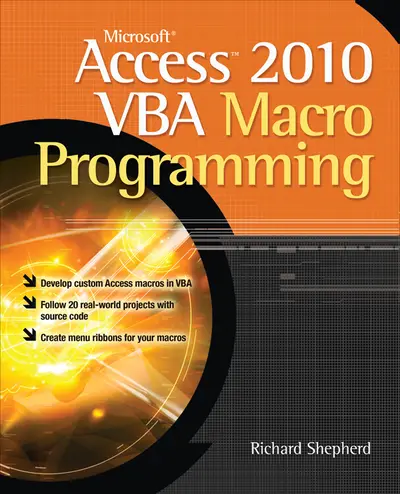My Account Details

ISBN10: 0071738576 | ISBN13: 9780071738576

Step 1 . Download Adobe Digital Editions to your PC or Mac desktop/laptop.
Step 2. Register and authorize your Adobe ID (optional). To access your eBook on multiple devices, first create an Adobe ID at account.adobe.com. Then, open Adobe Digital Editions, go to the Help menu, and select "Authorize Computer" to link your Adobe ID.
Step 3. Open Your eBook. Use Adobe Digital Editions to open the file. If the eBook doesn’t open, contact customer service for assistance.
Publisher's Note: Products purchased from Third Party sellers are not guaranteed by the publisher for quality, authenticity, or access to any online entitlements included with the product. Develop custom Access VBA macros Perfect for power users, Microsoft Access 2010 VBA Macro Programming reveals how to maximize the features and functionality of Access 2010. You'll get in-depth details on Access VBA programming and application development followed by 20 real-world projects--complete with source code--that show you how to set up specific subroutines and functions. This practical resource then explains how to include the subroutines in the Access menu system and transform a set of interrelated VBA macros into an Access add-in package. Create your own Access 2010 VBA macros right away with help from this hands-on guide. Learn how to: Create and enhance forms and reports Design custom dialog boxes and buttons Develop custom menus for the Ribbon Use SQL queries with VBA Create table macros Use Office object models to interact with other Microsoft applications Create and manipulate charts and graphs Work with external databases Add functionality to your programs with API calls Animate objects in Access Enhance database security Create audit trails Handle large text files Transfer data via FTP
Chapter 29. Monitoring Table Statistics; Chapter 30. Handling Large Text Files; Chapter 31. Create and Change Table Structures; Chapter 32. Create an Objects Inventory; Chapter 33. Manipulate Charts Colors; Chapter 34. Drill Down on Charts; Chapter 35. Use Excel For Output; Chapter 36. Using FTP in VBA; Chapter 37. What Happens When the 2-GB Limit is Reached; Chapter 38. Creating Menu Structures with the Ribbon; Chapter 39. Make Controls on Forms Interactive; Chapter 40. Set Up Levels of User Security; Appendix. ASCII Character Codes; Index
Need support? We're here to help - Get real-world support and resources every step of the way.